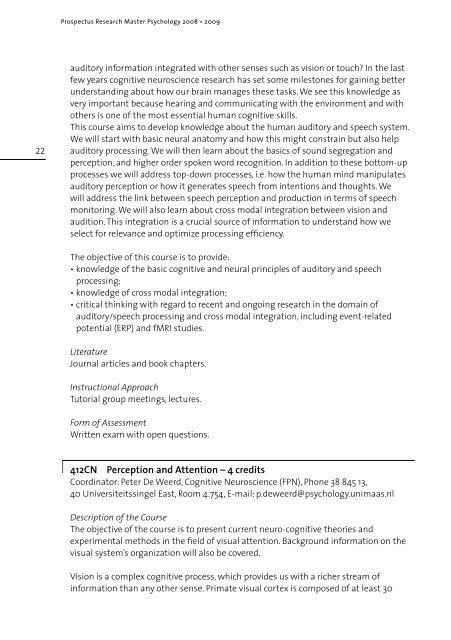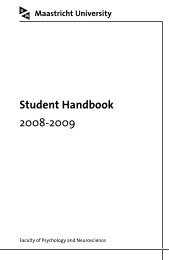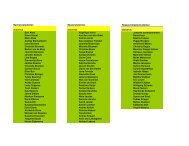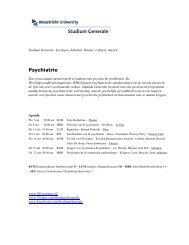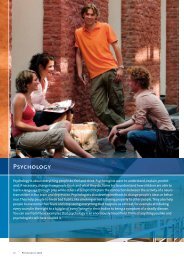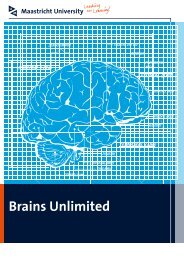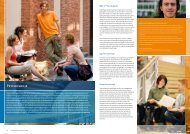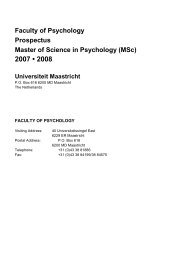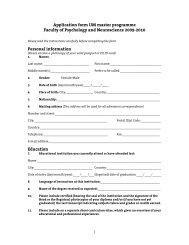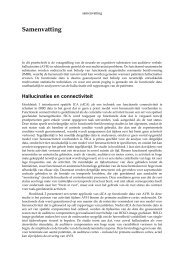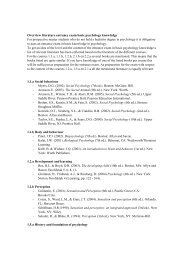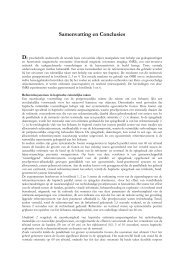Prospectus | 08/09 - Psychology and Neuroscience - Maastricht ...
Prospectus | 08/09 - Psychology and Neuroscience - Maastricht ...
Prospectus | 08/09 - Psychology and Neuroscience - Maastricht ...
Create successful ePaper yourself
Turn your PDF publications into a flip-book with our unique Google optimized e-Paper software.
<strong>Prospectus</strong> Research Master <strong>Psychology</strong> 20<strong>08</strong> • 20<strong>09</strong><br />
22<br />
auditory information integrated with other senses such as vision or touch? In the last<br />
few years cognitive neuroscience research has set some milestones for gaining better<br />
underst<strong>and</strong>ing about how our brain manages these tasks. We see this knowledge as<br />
very important because hearing <strong>and</strong> communicating with the environment <strong>and</strong> with<br />
others is one of the most essential human cognitive skills.<br />
This course aims to develop knowledge about the human auditory <strong>and</strong> speech system.<br />
We will start with basic neural anatomy <strong>and</strong> how this might constrain but also help<br />
auditory processing. We will then learn about the basics of sound segregation <strong>and</strong><br />
perception, <strong>and</strong> higher order spoken word recognition. In addition to these bottom-up<br />
processes we will address top-down processes, i.e. how the human mind manipulates<br />
auditory perception or how it generates speech from intentions <strong>and</strong> thoughts. We<br />
will address the link between speech perception <strong>and</strong> production in terms of speech<br />
monitoring. We will also learn about cross modal integration between vision <strong>and</strong><br />
audition. This integration is a crucial source of information to underst<strong>and</strong> how we<br />
select for relevance <strong>and</strong> optimize processing efficiency.<br />
The objective of this course is to provide:<br />
• knowledge of the basic cognitive <strong>and</strong> neural principles of auditory <strong>and</strong> speech<br />
processing;<br />
• knowledge of cross modal integration;<br />
• critical thinking with regard to recent <strong>and</strong> ongoing research in the domain of<br />
auditory/speech processing <strong>and</strong> cross modal integration, including event-related<br />
potential (ERP) <strong>and</strong> fMRI studies.<br />
Literature<br />
Journal articles <strong>and</strong> book chapters.<br />
Instructional Approach<br />
Tutorial group meetings, lectures.<br />
Form of Assessment<br />
Written exam with open questions.<br />
| 412CN Perception <strong>and</strong> Attention – 4 credits<br />
Coordinator: Peter De Weerd, Cognitive <strong>Neuroscience</strong> (FPN), Phone 38 845 13,<br />
40 Universiteitssingel East, Room 4.754, E-mail: p.deweerd@psychology.unimaas.nl<br />
Description of the Course<br />
The objective of the course is to present current neuro-cognitive theories <strong>and</strong><br />
experimental methods in the field of visual attention. Background information on the<br />
visual system’s organization will also be covered.<br />
Vision is a complex cognitive process, which provides us with a richer stream of<br />
information than any other sense. Primate visual cortex is composed of at least 30


